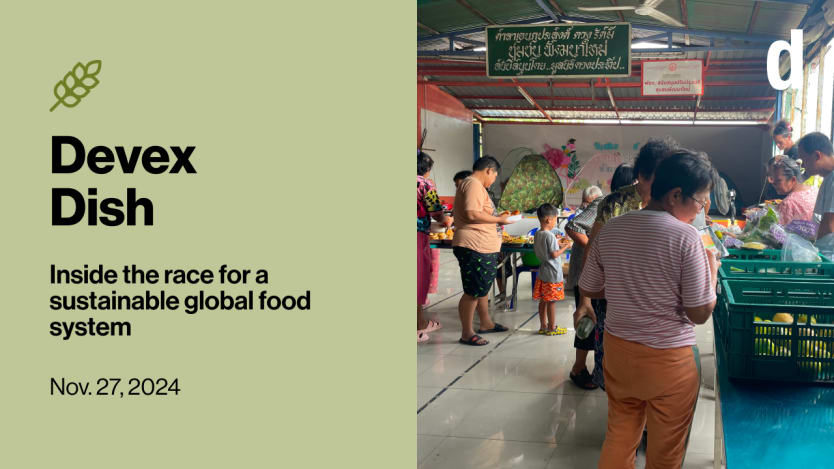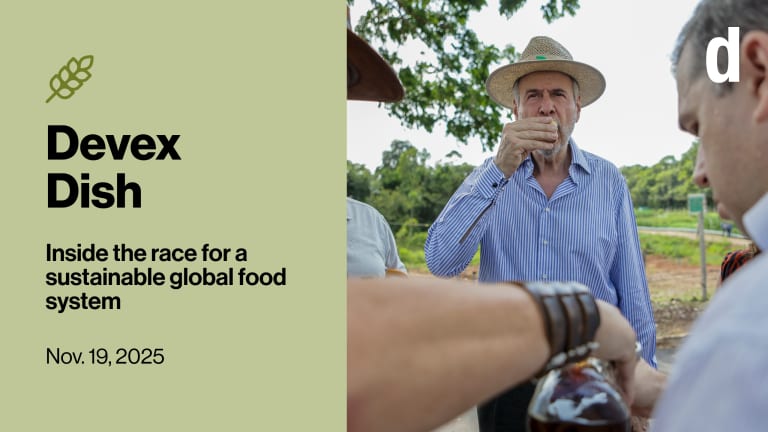
Happy early Thanksgiving to our U.S.-based readers! With Ayenat in Nairobi and Tania in Athens, we’re celebrating international-style by mixing up our favorite American and local dishes: Ayenat’s having potatoes cooked in coconut milk, and Tania’s pairing sweet potatoes with Greek lemon chicken.
As many Americans gather around a full table, we’re ever conscious that some 733 million people worldwide face chronic hunger. Yet food waste is a massive problem too: Every day over 1 billion meals find their way into trash cans around the world.
One potentially underutilized solution to these problems is food banks, writes Devex contributor Rebecca Root, who visited food banks in Thailand and Chile this year. The nonprofit Global FoodBanking Network, which supports food banks in over 50 countries, has seen a huge uptick in demand for food relief since the COVID-19 pandemic, with food banks serving nearly 40 million people last year, almost 10 million more than in 2022.
“If we can address the massive problem of food loss and waste and recover the safe, nutritious food before it goes to a landfill, we can feed millions and millions of people,” said the network’s President and CEO Lisa Moon.
Food banks can also be a climate change solution, as a growing body of evidence shows. Some 10% of global greenhouse gas emissions are derived from lost and wasted food. And not only are emissions generated by the production and transportation of food but if left to rot in a landfill, foodstuffs generate methane, one of the most powerful greenhouse gases.
To that end, the Global FoodBanking Network and its partners recently released Food Recovery to Avoid Methane Emissions, or FRAME, a methodology for calculating the emissions that are avoided by redistributing food that would otherwise be lost or wasted. Using the methodology, their pilot project with six community-led food banks in Mexico and Ecuador found that they prevented 816 metric tons of methane in a year — the equivalent of each food bank avoiding the annual emissions of 906 gasoline-powered cars — by redistributing food that would’ve gone to landfills.
Multiply that by the hundreds of food banks worldwide, and it equals a powerful solution to reducing emissions and hunger in one go. The network is pushing for food banks to increase their reach, and for governments to develop national strategies for reducing food loss and waste.
Read: Are food banks an ‘underutilized’ solution to hunger?
Good COP, bad COP
Food systems took center stage at COP29, with a dedicated day highlighting the intersection of agriculture, water, and climate change. But the spotlight didn’t quite shine as brightly as it did at last year’s COP28 in Dubai, which saw the signing of the UAE Declaration — a major milestone for integrating food systems into global climate action.
“There was a lot of activity on food and climate at COP29, which began on Day 1 with a meeting of heads of state and ministers to take stock of progress towards the COP28 Declaration,” says Ed Davey of the World Resources Institute.
“But there is still a lot of work to do to land food and climate at the heart of COP30; and to make sure that the world delivers in full on the headline commitment of the Declaration to ensure that every country includes food, food systems, and agriculture in their [nationally determined contribution, or NDC] by COP30,” he adds.
NDCs are due out by early 2025. Brazil — which will host COP30 next year in Belem — published its NDC during the first week of COP29. As a key player in both fossil fuels and food systems, Brazil's commitments hold weight, and it’s committing to cut greenhouse gas emissions by 59%-67% by 2035. Notably, the NDC emphasizes the country’s ambition to expand sustainable agriculture. To reach its goals, Brazil plans to focus on two strategies:
1. Turning degraded pastures into productive farmland, using approaches that combine crops, livestock, and even forests.
2. Boosting productivity by adopting more efficient farming methods and technologies.
One thing that’s missing: saving forests. About three-quarters of Brazil’s emissions come from deforestation in the name of agriculture, says Alexandre Prado, head of climate change at WWF-Brazil.
“Surprisingly, the new Brazil NDC does not have a clear target to end deforestation by 2030. … One of the country’s ‘national mitigation objectives’ is to expand sustainable agricultural and livestock production while guaranteeing food security,” he says. “In addition to beautiful words, Brazil will have to demonstrate the decoupling between the food systems and deforestation by 2030.”
The United Arab Emirates also unveiled its updated NDC to reduce agricultural sector emissions by 39% by 2035. It aims to achieve this through cutting-edge technologies and boosting domestic food self-sufficiency. In the coming months, we’ll keep an eye on other countries’ NDCs too.
Check out our COP29 reporting:
• COP29 special edition: Big promises, small Band-Aids, and Big Oil drama
• Listen: Did COP29 deliver?
• ICYMI: At COP29, a call to focus on smallholder farmers
+ Next up: We’re following the 16th session of the U.N. Convention to Combat Desertification, or COP16, taking place in Riyadh, Saudi Arabia, from Dec. 2-13. What issues do you think we should be watching? Email us at dish@devex.com
Number munching
14%
—That’s how much of the $9.1 billion in international public climate finance for agriculture and land use went to activities relevant to small-scale farmers in 2021-22, according to an analysis by Climate Focus that was released during COP29.
The study examined 40 climate and biodiversity projects by the Global Environment Facility and the Green Climate Fund and found that small-scale farmers and their organizations are routinely shut out of decision-making and have little, if any, direct access to funding.
Those findings are especially stark considering that small-scale farmers are often on the front lines of climate change and among the least equipped to adapt to it. They also produce one-third of the world’s food and up to 80% in some regions, such as sub-Saharan Africa and Asia.
GEF did not respond to a request for comment, while GCF pushed back against the report, telling Tania by email that the findings “do not do justice to the already significant smallholder farmer reach of GCF's investments.”
Read: Global climate funds are cutting out smallholder farmers, study finds
+ Devex Pro members can read about how despite declining global aid budgets, one U.N. agency focused on supporting small-scale farmers is gaining record support. Not a Devex Pro member yet? Start your 15-day free trial today.
Bringing home the bacon
Your next job?
Senior Climate Finance Specialist (Agribusiness)
Asian Development Bank
The Philippines
Chew on this
World Food Programme trucks reached North Darfur’s Zamzam camp on Friday for the first time since famine was declared there in August [UN News]
Return to Trumpworld: U.S. President-elect Donald Trump’s foreign aid selections may redefine U.S. global development. We made a handy guide to all the contenders to lead agencies such as USAID, MCC, and DFC. [Devex Pro]
South Africa is set to take over the yearlong G20 presidency starting Sunday. The country’s top three priorities are economic growth, food security, and artificial intelligence. [Devex]
World Food Prize President Terry Branstad will step down in January as the current COO Mashal Husain takes his place. The foundation is also seeking a CEO. [Devex]









